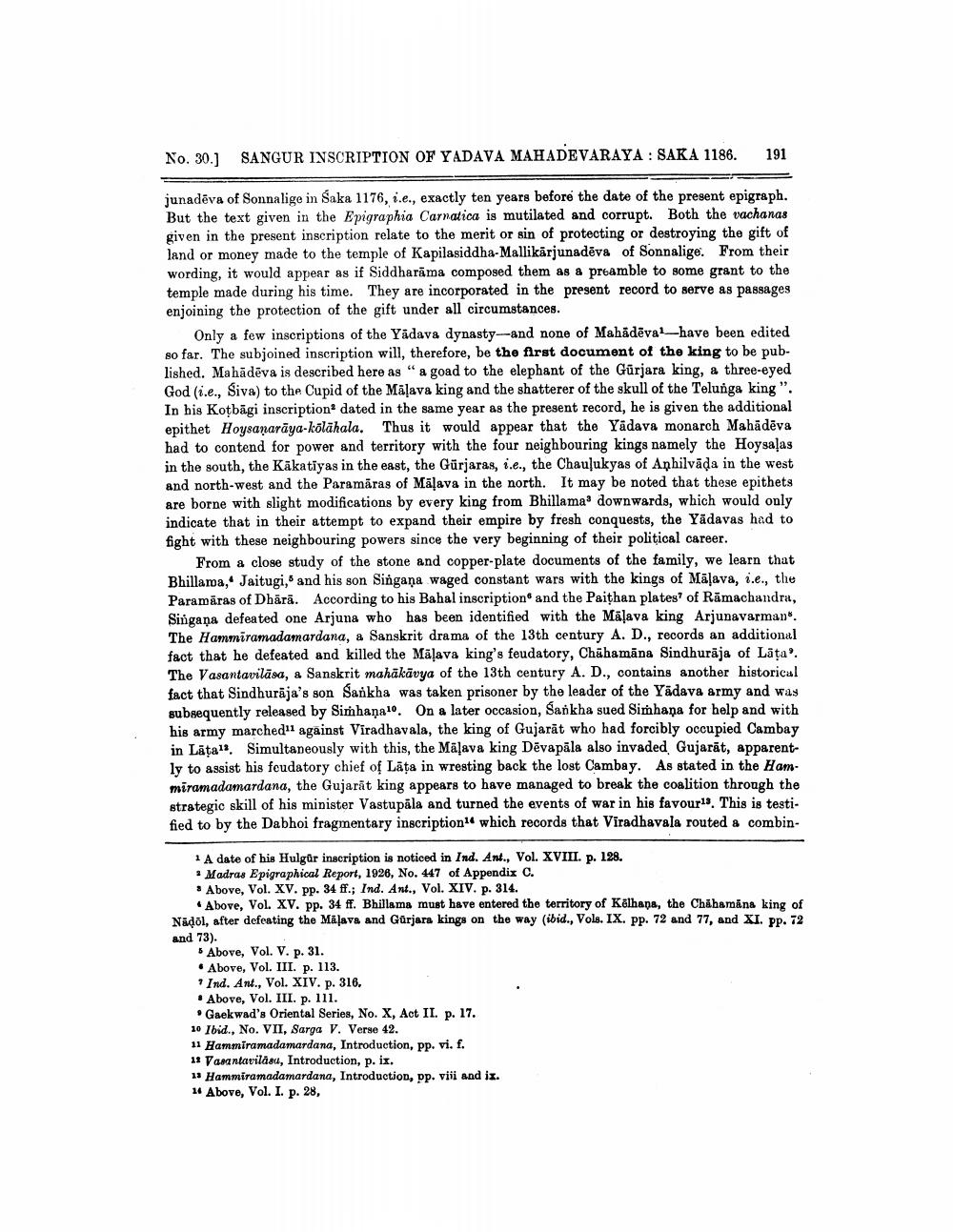________________
No. 30.) SANGUR INSCRIPTION OF YADAVA MAHADEVARAYA : SAKA 1186.
191
junadēva of Sonnalige in Saka 1176, i.e., exactly ten years before the date of the present epigraph. But the text given in the Epigraphia Carnatica is mutilated and corrupt. Both the vachanas given in the present inscription relate to the merit or sin of protecting or destroying the gift of land or money made to the temple of Kapilasiddha-Mallikarjunadēva of Sonnalige. From their wording, it would appear as if Siddharama composed them as a preamble to some grant to the temple made during his time. They are incorporated in the present record to serve as passages enjoining the protection of the gift under all circumstances.
Only a few inscriptions of the Yadava dynasty--and none of Mahadeval_have been edited so far. The subjoined inscription will, therefore, be the first document of the king to be published. Mahādēva is described here as "a goad to the elephant of the Gurjara king, a three-eyed God (i.e., Siva) to the Cupid of the Māļava king and the shatterer of the skull of the Telunga king ". In his Koțbāgi inscription dated in the same year as the present record, he is given the additional epithet Hoysanarāya-kölähala. Thus it would appear that the Yadava monarch Mahādēva had to contend for power and territory with the four neighbouring kings namely the Hoysaļas in the south, the Kakatiyas in the east, the Gürjaras, i.e., the Chauļukyas of Anhilvāda in the west and north-west and the Paramāras of Māļava in the north. It may be noted that these epithets are borne with slight modifications by every king from Bhillama' downwards, which would only indicate that in their attempt to expand their empire by fresh conquests, the Yädavas had to fight with these neighbouring powers since the very beginning of their political career.
From & close study of the stone and copper-plate documents of the family, we learn that Bhillama, Jaitugi,' and his son Singana waged constant wars with the kings of Māļava, i.e., the Paramäras of Dhärā. According to his Bahal inscription and the Paithan platest of Rāmachandru, Singana defeated one Arjuna who has been identified with the Mälava king Arjunavarman The Hammiramadamardana, a Sanskrit drama of the 13th century A. D., records an additional fact that he defeated and killed the Māļava king's feudatory, Chāhamāna Sindhurāja of Lāta'. The Vasantavilāsa, & Sanskrit mahākāvya of the 13th century A. D., contains another historical fact that Sindhurāja's son Sankha was taken prisoner by the leader of the Yadava army and was subsequently released by Simhana''. On a later occasion, Sankha sued Simhana for help and with his army marched against Viradhavala, the king of Gujarat who had forcibly occupied Cambay in Läța. Simultaneously with this, the Māļava king Dēvapāla also invaded Gujarāt, apparently to assist his feudatory chief of Lāta in wresting back the lost Cambay. As stated in the Hammiramadamardana, the Gujarāt king appears to have managed to break the coalition through the strategic skill of his minister Vastupāla and turned the events of war in his favour'. This is testified to by the Dabhoi fragmentary inscription which records that Viradhavala routed a combin
1 A date of his Hulgur inscription is noticed in Ind. Ant., Vol. XVIII. p. 128. * Madras Epigraphical Report, 1926, No. 447 of Appendix C. • Above, Vol. XV. pp. 34 ff.; Ind. Ant., Vol. XIV. p. 314.
• Above, Vol. XV. pp. 34 ff. Bhillama must have entered the territory of Kolhana, the Chihamina king of Nadol, after defeating the Malave and Gurjara kings on the way (ibid., Vols. IX. pp. 72 and 77, and XI. pp. 72 and 73).
* Above, Vol. V. p. 31. • Above, Vol. III. p. 113. * Ind. Ant., Vol. XIV. p. 316. . Above, Vol. III. p. 111.
Gaekwad's Oriental Series, No. X, Act II. p. 17. 10 Ibid., No. VII, Sarga V. Verse 42. 11 Hammiramadamardana, Introduction, pp. vi. f. 11 Vasantavilās, Introduction, p. ix. 11 Hammiramadamardana, Introduction, pp. viii and iz. 11 Above, Vol. I. p. 28,




